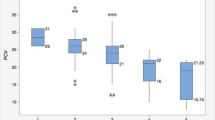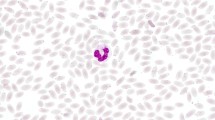Abstract
Haemonchus contortus is a nematode parasite that causes anaemia and affects the health of sheep. The mean corpuscular haemoglobin concentration (MCHC) is an excellent indicator to detect anaemia that could help to characterize resistant or susceptible lambs to gastrointestinal nematodes. The aim of this study was to evaluate the predictive value of MCHC in detecting changes in red blood cells and their relation to anaemia in lambs re-infected with H. contortus. An analysis of information was performed using 24 Pelibuey lambs previously infected in grazing, dewormed and experimentally re-infected with H. contortus. At the first haematological sampling (admission) the lambs were classified based on MCHC quartiles (Q). Subsequently, the lambs were housed for 56 days. Blood samples were taken every seven days to determine the haematological parameters using an impedance haematological instrument. Confidence limits were constructed with the records of the lambs that recovered their haematological parameters. Each quartile was analysed as a treatment in a repeated measures design over time. To know the optimal combination of sensitivity and specificity of MCHC to detect anaemia a curve of receiver operating characteristic (ROC) curve and the cut-off values were evaluated. In quartile 4 (Q4), lambs showed the highest faecal egg count (FEC, 764 eggs/g of faeces), mean corpuscular haemoglobin (17.0 pg) and MCHC (54.6 g/dL). This group also presented the lowest RBC values (5.8 × 106/mL), haematocrit (HCT, 18.3%), total plasma protein (5.7 g/dL), and HGB (9.7 g/dL). The optimal point of MCHC with ROC curve was 42.4 (sensitivity 88.2% and specificity 86.5%); the area under the curve was 0.91 (CI 95%, 0.86–0.96). These results are related to the haematological effects caused by H. contortus in susceptible lambs. In conclusion, the highest FEC and lower HCT in Q4 are important elements of the haematological damage caused by H. contortus and could identify susceptible lambs.



Similar content being viewed by others
Availability of data and materials
The datasets analysed during the current study are available from the corresponding author on reasonable request.
Abbreviations
- MCHC:
-
Mean corpuscular haemoglobin concentration
- HGB:
-
Haemoglobin
- MCV:
-
Means cellular volume
- RBC:
-
Red blood cell count
- Q:
-
Quartile
- ROC:
-
Receiver operating characteristic
- FEC:
-
Faecal egg count
- HCT:
-
Haematocrit
- CI:
-
Confidence interval
- GIN:
-
Gastrointestinal nematode
- EOS:
-
Eosinophil count
- TPP:
-
Total plasma protein
- RDW:
-
Red blood cell distribution width
- PLT:
-
Platelets
- PCT:
-
Plateletcrit
- P-LCR:
-
Platelet-large cell ratio
- MPV:
-
Mean platelet volume
- PDW:
-
Platelet distribution width
- WBC:
-
White blood cell count
- LYM:
-
Lymphocytes
- GRAN:
-
Granulocytes
- MID:
-
Median cells
References
Andronicos NM, Henshall JM, Le Jambre LF et al (2014) A one shot blood phenotype can identify sheep that resist Haemonchus contortus challenge. Vet Parasitol 205:595–605. https://doi.org/10.1016/j.vetpar.2014.08.009
Bell A, McNally J, Smith DV et al (2019) Quantification of differences in resistance to gastrointestinal nematode infections in sheep using a multivariate blood parameter. Vet Parasitol 270:31–39. https://doi.org/10.1016/j.vetpar.2019.05.007
Billett H (1990) Hemoglobin and Hematocrit. In: Walker H, Hall W, Hurst J (eds) Clinical Methods: The History, Physical, and Laboratory Examinations, 3rd edn. Butterworth Publishers, Boston, pp 718–719
Birge DB, Muller AF, Fantinato-Neto P et al (2014) Avaliação do quadro eritrocitário e da repercussão do estado anêmico no leucograma de caprinos com verminose gastrintestinal. Pesqui Vet Bras 34:199–204. https://doi.org/10.1590/S0100-736X2014000300001
Boule (2003) Manual de Usuario Medonic CA620/530. Boule Medical AB, Stockholm, Suecia
Cabaret J, Gasnier N, Jacquiet P (1998) Faecal egg counts are representative of digestive-tract strongyle worm burdens in sheep and goats. Parasite 5:137–142. https://doi.org/10.1051/parasite/1998052137
Casanova VP, Aires AR, Collet SG et al (2018) Iron supplementation for lambs experimentally infected by Haemonchus contortus: Response to anemia and iron store in the bone marrow. Pesqui Vet Bras 38:1543–1548. https://doi.org/10.1590/1678-5150-PVB-5490
Claerebout E, De Wilde N, Van Mael E, et al (2020) Anthelmintic resistance and common worm control practices in sheep farms in Flanders, Belgium. Vet Parasitol Reg Stud Reports 100393
Colditz IG, Le Jambre LF (2008) Development of a faecal occult blood test to determine the severity of Haemonchus contortus infections in sheep. Vet Parasitol 153:93–99. https://doi.org/10.1016/j.vetpar.2008.01.025
Cringoli G, Rinaldi L, Veneziano V et al (2004) The influence of flotation solution, sample dilution and the choice of McMaster slide area (volume) on the reliability of the McMaster technique in estimating the faecal egg counts of gastrointestinal strongyles and Dicrocoelium dendriticum in sheep. Vet Parasitol 123:121–131
Cruz-Tamayo A, González-Garduño R, Torres-Hernández G et al (2020) Comparison of two phenotypical methods to segregate resistant and susceptible lambs to parasitic nematodes. Austral J Vet Sci 52:9–18. https://doi.org/10.4067/S0719-81322020000100103
Da Silva AS, Schafer AS, Aires AR et al (2013) E-ADA activity in erythrocytes of lambs experimentally infected with Haemonchus contortus and its possible functional correlations with anemia. Res Vet Sci 95:1026–1030. https://doi.org/10.1016/j.rvsc.2013.07.008
Dawkins H, Windon R, Eagleson G (1989) Eosinophil responses in sheep selected for high and low responsiveness to Trichostrongylus colubriformis. Int J Parasitol 19:199–205
Ferreira J, Sotomaior CS, Bezerra ACD et al (2019) Sensitivity and specificity of the FAMACHA© system in tropical hair sheep. Trop Anim Health Prod 51:1767–1771. https://doi.org/10.1007/s11250-019-01861-x
Gonçalves TC, Alencar MM, Giglioti R et al (2018) Resistance of sheep from different genetic groups to gastrointestinal nematodes in the state of São Paulo, Brazil. Small Rumin Res 166:7–11. https://doi.org/10.1016/j.smallrumres.2018.07.003
Guo Z, González JF, Hernandez JN et al (2016) Possible mechanisms of host resistance to Haemonchus contortus infection in sheep breeds native to the Canary Islands. Sci Rep 6:1–14. https://doi.org/10.1038/srep26200
Jones ML, Allison RW (2007) Evaluation of the ruminant complete blood cell count. Vet Clin North Am - Food Anim Pract 23:377–402. https://doi.org/10.1016/j.cvfa.2007.07.002
Joosten E, Lioen P, Brusselmans C et al (2013) Is analysis of the reticulocyte haemoglobin equivalent a useful test for the diagnosis of iron deficiency anaemia in geriatric patients? Eur J Intern Med 24:63–66. https://doi.org/10.1016/j.ejim.2012.09.001
Katsogiannou E, Athanasiou L, Christodoulopoulos G, Plozopoulou Z (2018). Diagnostic approach of anemia in ruminants. J Hell Vet Med Soc 69:1033–1046. https://doi.org/10.12681/jhvms.18866
Leask R, van Wyk JA, Thompson PN, Bath GF (2013) The effect of application of the FAMACHA© system on selected production parameters in sheep. Small Rumin Res 110:1–8. https://doi.org/10.1016/j.smallrumres.2012.07.026
Mcrae KM, Stear MJ, Good B, Keane OM (2015) The host immune response to gastrointestinal nematode infection in sheep. Parasite Immunol 37:605–613. https://doi.org/10.1111/pim.12290
Ngetich EC, Ngeiywa M, Ng’wena GM, Chemwolo L, (2019) Haematological Parameters by Age and Sex of Asymptomatic Indigenous Cattle and Sheep Infected with Gastrointestinal Parasites in Kerio Valley, Kenya. Am J Biomed Res 7:44–50. https://doi.org/10.12691/ajbr-7-2-4
NRC (2007) Nutrient requirements of small ruminants: sheep, goats, cervids, and new world camelids. National Academy Press, Washintgton, DC
Palomo-Couoh JG, Aguilar-Caballero AJ, Torres-Acosta JFJ, González-Garduño R 2017Comparing the phenotypic susceptibility of Pelibuey and Katahdin female lambs against natural gastrointestinal nematode infections under hot humid tropical conditionsParasitol Res 116https://doi.org/10.1007/s00436-017-5437-7
Paterakis GS, Laoutaris NP, Alexia SV et al (1994) The effect of red cell shape on the measurement of red cell volume. A proposed method for the comparative assessment of this effect among various haematology analysers. Clin Lab Haematol 16:235–245. https://doi.org/10.1111/j.1365-2257.1994.tb00416.x
Polizopoulou ZS (2010) Haematological tests in sheep health management. Small Rumin Res 92:88–91. https://doi.org/10.1016/j.smallrumres.2010.04.015
Ramby AL, Goodman DM, Wald EL, Weiss SL (2015) Red blood cell distribution width as a pragmatic marker for outcome in pediatric critical illness. PLoS ONE 10(6):1–13. https://doi.org/10.1371/journal.pone.0129258
Rodríguez AV, Goldberg V, Viotti H, Ciappesoni G (2015) Early detection of Haemonchus contortus infection in sheep using three different faecal occult blood tests. Open Vet J 5:90–97
Said AS, Spinella PC, Hartman ME et al (2017) Red blood cell distribution width: biomarker for red cell dysfunction and critical illness outcome? Pediatr Crit Care Med 18(2):134–142. https://doi.org/10.1097/PCC.0000000000001017
SAS (2017) SAS/STAT User´s Guide, Release 6. Cary, NC, USA
Thienpont D, Rochette F, Vanparijs OFJ (2003) Diagnosing helminthiasis by coprological examination, Third. Janssen Research Foundation, Beerse, Belgium
Weiss D, Wardrop J (2010) Schalm´s veterinary Hematology, 6Th edn. Wiley-Blackwell, Iowa, USA
Zaragoza-Vera CV, Aguilar-Caballero AJ, González-Garduño R et al (2019) Variation in phenotypic resistance to gastrointestinal nematodes in hair sheep in the humid tropics of Mexico. Parasitol Res. https://doi.org/10.1007/s00436-018-06201-w
Funding
Partial financial support was received from Postgraduate College and Chapingo University.
Author information
Authors and Affiliations
Contributions
Conceptualization: R. González-Garduño. Methodology: G. Jiménez-Penago. Formal Analysis and Investigation: O. Hernández-Mendo, R. González Garduño. Writing-original draft preparation: G. Torres-Hernández, O.M. Torres-Chable. Writing-review and editing: E. Maldonado-Simán. Funding Acquisition: O. Hernández-Mendo. Resources: N/A. Supervision: E. Maldonado-Simán.
Corresponding author
Ethics declarations
Ethical approval
This study involved blood sampling from lambs. The study protocol was in accordance to regulations for the use and care of animals intended for research in the Postgraduate College, approved in November 2016 and based on Official Mexican Standard-062-Z00-1999, on the Technical Specifications for the Production, Care and Use of Laboratory Animals. Collection of blood samples was carried out by veterinarians adhering to these regulations.
Consent to participate
All listed authors have approved to participate in the manuscript.
Competing interests
No conflict of Interest has been declared.
Additional information
Publisher's note
Springer Nature remains neutral with regard to jurisdictional claims in published maps and institutional affiliations.
Rights and permissions
About this article
Cite this article
Jiménez-Penago, G., Hernández-Mendo, O., González-Garduño, R. et al. Mean corpuscular haemoglobin concentration as haematological marker to detect changes in red blood cells in sheep infected with Haemonchus contortus. Vet Res Commun 45, 189–197 (2021). https://doi.org/10.1007/s11259-021-09800-8
Received:
Accepted:
Published:
Issue Date:
DOI: https://doi.org/10.1007/s11259-021-09800-8




